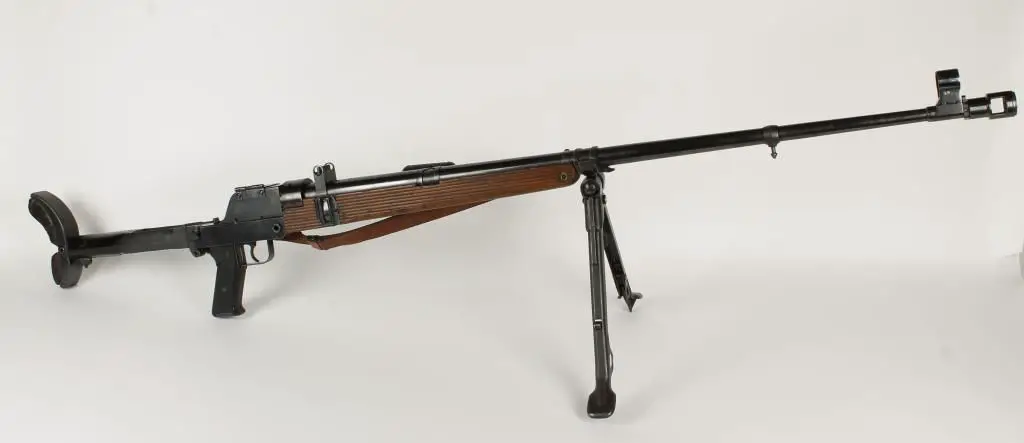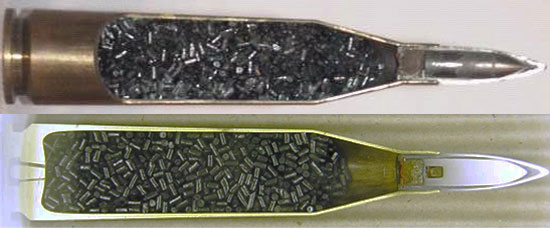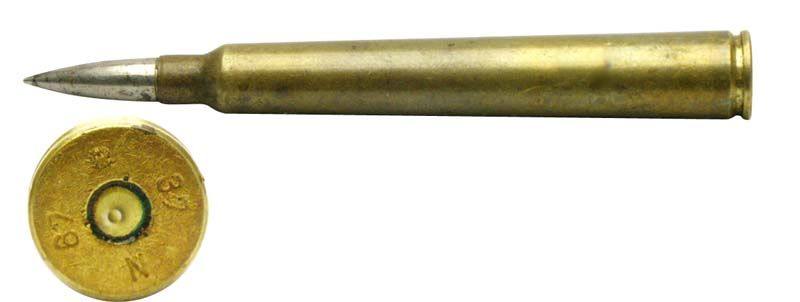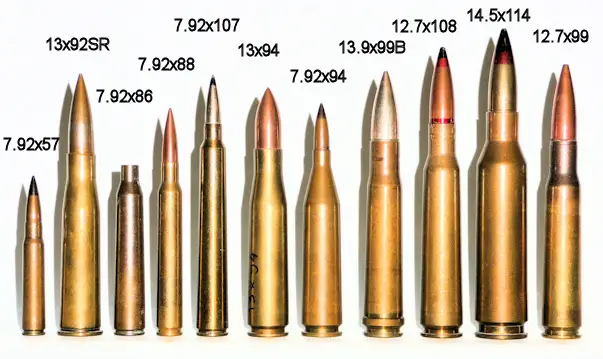Among the more unusual and inexplicable — ah, hell, let’s just say foolhardy — loads ever manufactured for a firearm were strangely multipurpose rounds for the German World War II anti-tank rifles. These gigantic rifles fired a kinetic energy penetrator of 7.92mm from a gigantic 94mm rimless casing at blistering speeds1. But even beyond its “pinhead” appearance, the round had a peculiar feature, that is as far as we know unique in the world of ammunition.

This illustration came from the Russian site Kopania.rf, which has comprehensive coverage of variants of the 7.93 x 94 P318.
While the idea of a rifle-caliber or MG-caliber AT gun wasn’t completely off the wall — many of the major powers of Europe, and some minor ones like Poland and Spain, pursued the idea in the 1920s and 30s — the particular loading of the Germans was. To an extent, it was a fairly standard API or API-T round, with a copper jacket over a steel (or later, tungsten) penetrator. Here’s what an Allied intelligence publication had to say:
“The Germans possess gas grenades, with which their parachute troops might be equipped. Ammunition for antitank rifles, models 38 and 39, includes armor-piercing tracer bullets charged with tear gas.”2
And no, this wasn’t one of those cases where the intel weenies were chasing chimeras. There really was a tear-gas capsule in the round, just forward of the tracer mixture, set in the base of the hard metal penetrator. In packaged rounds, it’s indicated by the post-number letters “Rs” for “Reizstoff” or “Irritant agent.”
You have to wonder: what were they thinking? “We’re going to send a little hunk of tungsten” — well, they were Germans, so they were going to send a little hunk of wolfram — “to rattle around in their tank, and then we’ll really let ’em have it: tear gas!” But that was, exactly, what they were thinking. The German ordnance officers thought the round too uncertain a tank kill, and the tear gas was one little sweetener to encourage the crew to depart their iron foxhole.
As it happened, it didn’t work. The little gas capsule usually broke off on impact and was found lying next to the tank. Sure enough, it was the steel or tungsten penetrator that did the hard work.
While this little capsule of gas may have been a technical violation of the international law of war (irritants and tear gases are a grey area), the gas aspect of the cartridge was so meager that, as far as we can tell, the Allies never uttered a word of protest, nor was there any war-crimes trials for the ordnance officers (not for this, anyway). It’s just a flaky footnote to the development of World War weapons.
The two weapons that fired this odd 7.92 x 94mm for the Deutsche Wehrmacht were the Panzerbuchse (PzB) 38 from Rheinmettal-Borsig and the PzB 39 from the Gustloff-Werke. The PzB 38 was a bit of a flop, and only 1,600 were made; they’re extremely rare today, and were problematical in the field. The weight and complexity of the PzB 38 stemmed in part from its design — unlike the WWI AT rifle, which was a scaled-up single-shot Mauser, the PzB 38 used artillery-piece design concepts — a falling block, a recoiling “carriage,” and automatic ejection.
That’s why the Wehrmacht went so quickly from the PzB 38 to the PzB 39, which was cheaper, simpler, and more reliable — not to mention, almost 4 kilograms lighter. It dumped the recoil system and automatic breech opening — trading some punishment of the gunner, and a fast second shot, for lightness and mobility.

Surviving PzB 39s are almost as rare as PzB 38s despite much higher production, because most were converted to GrB 39s. Five survivors are known. This example, SN 6462, was auctioned in 2013. More images at the Auction Link.
It also wrung another 55 m/s (180 fps) out of the same cartridge. Over 30,000 of these were made, and they were deployed Army wide by Operation Barbarossa, although they never matched the intended 81 rifles per infantry division.
By midwar the 7.92 was hopeless on medium tanks, but could still penetrate light armored vehicles. You didn’t want to fire this gun at a T-34 or the frontal armor of a Sherman; it would make the guys inside mad, and then they’d want to fight. The Wehrmacht had been expecting more of the T-26s and BT-5s they faced in Spain, and the T-34 was an unpleasant shock3
A next-generation anti-tank rifle competition, calling for a semi-auto, brought forth prototypes from several firms: Mauser, Walther, Krieghoff and Gustloff. But tank armor, driven to greater thicknesses by anti-tank artillery, dimmed the prospects of the 7.92 hypervelocity round as a tank-slayer.
The Germans, facing the obsolescence of the PzB 39, had actually begun converting them to grenade launchers (Granatenbüchse 39); the GrB 39 had the standard rifleman’s cup-discharger but the larger shell meant that the wood-bullet grenade-launcher blank could drive a grenade much farther than a mere rifle could. In this capacity, the rifle soldiered on to V-E Day. This is one of those rounds, the 7.92mm Triebpatrone Granatenbüchse 318:
The 7.92 x 94 wasn’t, by the way, the largest rifle-caliber round of the war. The Poles made a spectacular AT rifle in the 1930s, the Karabin Przeciwpancerny wz.35, that fired this spectacular 7.92 x 107mm round, the 7.92 DS, designed by Polish ordnance officer Tadeusz Felsztyn4 for a repeating rifle designed by Josef Maroszek. The muzzle velocity was a barrel-melting 1275 m/s (4,183 fps)5.
It could penetrate even more armor at 100 and 300m than its German competitor, and was every bit as obsolete. The barrel life of these seriously oversized cartridges was, as you might expect, measured in scores or, at most, a few hundred rounds. The US experimented with AT rifles but never issued one; Britain issued the 0.55 in. Boys Anti Tank Rifle, but all were doomed by the rapid evolution of tank armor under the evolutionary pressure of world war.
The Polish round was unique among them in that it did not have a tungsten, or even steel, penetrator. While its lead-cored round could penetrate at close range because of its velocity, at longer ranges, it squashed on the outside of the armor and knocked a divot off the inside, killing the vehicle or the inhabitants with the effects of this spalling.
This image, from Williams, shows a collection of AT rifle rounds, issued and experimental.
One ballistic detail about the German and Polish AT rifles — given the Mach 4 (sea level, standard day) velocity of these 7.92mm rounds, they had a very flat trajectory. That means that they didn’t need the elaborate sights of many period rifles — they were often sighted on 300 or 400 meters, and basically shot point-blank at anything on the battlefield, with no hold-over or -under, and therefore, no elevation adjustment, required.
Notes
- Depending on the rifle, its muzzle velocity was 1210 or 1265 m/s — that’s 3,970 to 4,150 fps.
- War Department. 1943-03 Intelligence Bulletin Vol 01 No 07. Page uncertain (repaginated electronic OCR scan).
- Of which, more later. We’ve come across a purported first-hand report of a first-encounter with the excellent Soviet tank, by a rare invasion survivor.
- Out of curiosity, we sought more information about Felsztyn. With a Jewish sounding name, and as a Polish officer, he was equally doomed whether the Nazis or the Soviets got him. What we learned deserves its own blog post!
- Williams, generally a solid source, says 1,220 m/s. He also gives only the lower number for the 12.7 x 94.
Sources
Hofbauer, M. Panzerfaust: WWII German Infantry AntiTank Weapons: Page 6: Tank Rifles. Archived from Geocities (defunct) in October 2009. Retrieved from: http://www.oocities.org/augusta/8172/panzerfaust6.htm
Parada, George. German Anti-Tank rifles — Panzerbüchse. AchtungPanzer.com. Retrieved from: http://www.achtungpanzer.com/german-anti-tank-rifles-panzerbuchse.htm
Popenker, Maxim. Panzerbüchse PzB-38 (Pz.B.38) and PzB-39 (Pz.B.39) anti-tank rifle (Germany). Modern Firearms. Retrieved from: http://world.guns.ru/atr/de/pzb3-pzb39-e.html
Uncredited. The German PxB 38/39 (Panzerbuchse). Antitank.co.uk. Retrieved from: http://www.antitank.co.uk/german1.ht
United States. War Department. 1943-03 Intelligence Bulletin Vol 01 No 07. Washington, 1943.
Williams, Anthony G. An Introduction to Anti-Tank Rifle Cartridges. The Cartridge Researcher, 11/12 2004. Retrieved from: http://www.quarryhs.co.uk/ATRart.htm

Kevin was a former Special Forces weapons man (MOS 18B, before the 18 series, 11B with Skill Qualification Indicator of S). His focus was on weapons: their history, effects and employment. He started WeaponsMan.com in 2011 and operated it until he passed away in 2017. His work is being preserved here at the request of his family.






8 thoughts on “Most Foolhardy Round Ever?”
Wow. Awesome write up! Even though they were obscure, those AT rifles were something else. Very cool.
Is this a contender?
http://en.wikipedia.org/wiki/4.25mm_Liliput
There’s a post on this page on the 2.7 and 3mm Kolibri that shows them next to a 4.25 Liliput. I’m not sure why any of these were invented, except for smallest-gun bragging rights.
I remember when you could have bought a similar one out of the “Ye Olde Hunter’s Lodge” catalogue. ‘Course if I had had any brains back then I would have picked up the Solothuern 20mm anti-tank gun for $189.99 instead.
Surprising, the detail about the Polish lead core bullet and intended spalling effect.
That’s in the link to Anthony Williams’s article. I believe it’s new research that he added only to the online version!
“…equally doomed.” Not quite. The mystery of the Katyn Forest massacres isn’t who ordered them – Stalin/Beria – but who ordered them stopped when large numbers of Polish officers were still alive in other POW camps. These men later served with Gen’l Anders Army in Italy, or with a parallel Soviet-puppet Polish Army
The officers of the Austro-Hungarian empire were allowed to procure their personal sidearms, the higher the rank the smaller the pistol so as not to disturb the dashing looks of their dress uniforms.
http://en.m.wikipedia.org/wiki/2_mm_Kolibri
The inventor was a watchmaker turned gunsmith.
After the manufacturer’s death his workshop was cleared out and all remaining pistols, parts and toolings were unceremoniously dumped into the Danube river.
http://de.wikipedia.org/wiki/Franz_Pfannl
When a Small Arms Repairs guy with an odd sense of humor once mentioned the 7,92x94mm I thought he was making fun of certain well-known Germanic character traits, until he dug up this absurdly microcephalic looking round.